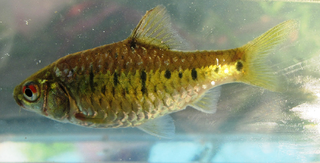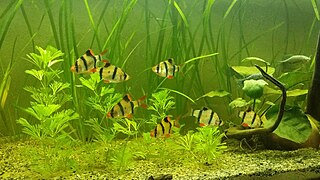
The tinfoil barb is a tropical Southeast Asian freshwater fish of the family Cyprinidae. This species was originally described as Barbus schwanenfeldii by Pieter Bleeker in 1853, and has also been placed in the genera Barbodes and Puntius. The specific epithet is frequently misspelled schwanefeldii.

Barbodes semifasciolatus, the Chinese barb, is a species of cyprinid fish native to the Red River basin in southeast Asia where they occur in fresh waters at depths of 5 metres (16 ft) or less. The captive variant popularly known as the gold barb or Schuberti barb is an extremely popular aquarium fish.

The tiger barb or Sumatra barb, is a species of tropical cyprinid fish. The natural geographic range reportedly extends throughout the Malay Peninsula, Sumatra and Borneo in Indonesia, with unsubstantiated sightings reported in Cambodia. Tiger barbs are also found in many other parts of Asia, and with little reliable collection data over long periods of time, definite conclusions about their natural geographic range versus established introductions are difficult. Tiger barbs may sometimes be confused with Puntigrus anchisporus, Puntigrus navjotsodhii, or Puntigrus partipentazona, which are similar in appearance, the only differences being the slightly different stripe pattern and the number of scales these fish have.

The checker barb is a species of cyprinid fish endemic to creeks, rivers, and lakes in Sumatra, Indonesia. It has also been established in the wild in Colombia. The adult males have red fins with black tips. It will grow up to a length of 5 centimetres (2.0 in) TL. This species is the only known member of its genus.
The fiveband barb is a species of cyprinid freshwater fish from Southeast Asia. This species is restricted to blackwater streams and peat swamps in northwestern Borneo and possibly Peninsular Malaysia, but it has often been confused with the more widespread, closely related D. hexazona, which is similar except that it lacks the black spot at the rear base of the dorsal fin seen in D. pentazona.

The Denison barb, Denison's barb, Miss Kerala, red-line torpedo barb, or roseline shark is an endangered species of cyprinid fish endemic to the fast-flowing hill streams and rivers of the Western Ghats in India. It is commonly seen in the aquarium trade; pet collection caused it to become endangered and is its single major threat.

The golden barb or golden dwarf barb is a species of cyprinid fish native to inland waters in Asia, and is found in Pakistan, India, and Bangladesh. It has also been introduced to waters in Colombia. It natively inhabits rivers, and standing water with a silty bottom. They live in a tropical climate in water with a 6.0 - 6.5 pH, a water hardness of 8 - 15 dGH, and a temperature range of 68 - 77 °F. It feeds on benthic and planktonic crustaceans, and insects. This species can grow in length up to 5.1 centimetres (2.0 in) TL. It can also be found in the aquarium trade.

Puntius is a genus of small freshwater fish in the family Cyprinidae native to South Asia and Mainland Southeast Asia, as well as Taiwan.

The Arulius barb is a tropical cyprinid fish native to the Kaveri River basin of south east India. Other common names include Tamiraparani barb, Silas barb and longfin barb.

Barbonymus is a ray-finned fish genus in the family Cyprinidae, containing some barb species. The genus was only established in 1999, with the tinfoil barb as type species; thus, these fish are sometimes collectively called tinfoils. The new genus was established in recognition of the fact that some large Asian "barbs", formerly rather indiscriminately lumped in Barbus, Barbodes and Puntius, form a distinct evolutionary lineage.

Barbodes binotatus, commonly known as the spotted barb or common barb, is a tropical species of cyprinid fish endemic to Java, Indonesia.

Barbodes everetti, the Clown barb or Everett's barb is a species of cyprinid fish native to Borneo and Sumatra. It inhabits clear streams in forested foothills and can also be found in forest floor puddles as shallow as 15 centimetres (5.9 in) or less. Its diet consists of small crustaceans, worms, insects and plant material. This species can reach a length of 15 centimetres (5.9 in) TL. It can also be found in the aquarium trade.

Barbodes lateristriga, the spanner barb or T-barb, is a species of cyprinid fish native to the Malay Peninsula and the island of Borneo. It can reach a length of 18 centimetres (7.1 in) TL. This species can also be found in the aquarium trade.

Puntigrus partipentazona, the Dwarf Tiger Barb, is a species of cyprinid fish native to Southeast Asia where it is found in the Mekong, Mae Klong, and Chao Phraya basins of Thailand, the Malay Peninsula, and coastal streams of southeast Thailand and Cambodia where it occurs in streams and impoundments with dense weed growth. It can also be found in the aquarium trade. It is frequently misidentified as the similar Puntigrus tetrazona.

Barbodes is a genus of small to medium-sized cyprinid fish native to tropical Asia. The majority of the species are from Southeast Asia. Many species are threatened and some from the Philippines are already extinct. A survey carried out in 1992 only found three of the endemic Barbodes species, and only two were found in 2008. Several members of this genus were formerly included in Puntius.
Phallostethus dunckeri is a species of fish in the family Phallostethidae. It is endemic to Malaysia.
Barbodes dorsimaculatus, the blackline barb, is a species of cyprinid fish endemic to Sumatra. This species can reach a length of 3.1 centimetres (1.2 in) TL. It can also be found in the aquarium trade.
Barbodes katolo is an extinct species of cyprinid fish endemic to Lake Lanao in Mindanao, the Philippines. Males of this species reached a length of 11 centimetres (4.3 in) SL while females only reached 9.5 centimetres (3.7 in).
The goldfinned barb is a subspecies of ray-finned fish in the genus Barbodes. It has been reported to be from Singapore, but the validity of this taxon is questionable and some authorities treat it purely as a synonym of Barbodes semifasciolatus.
Paul Georg Egmont Duncker was a German ichthyologist.














